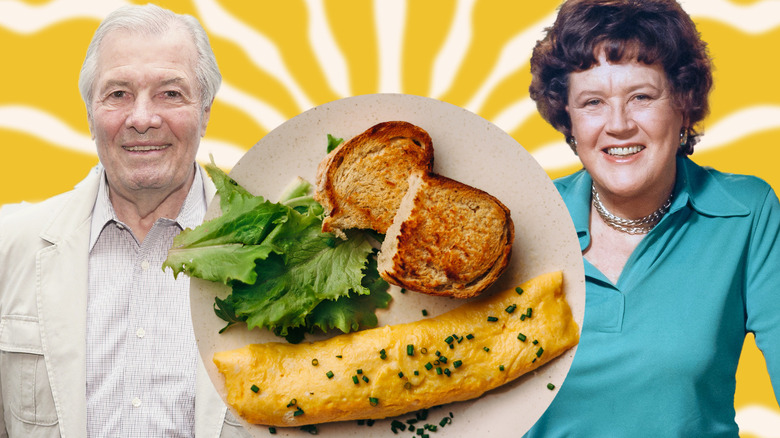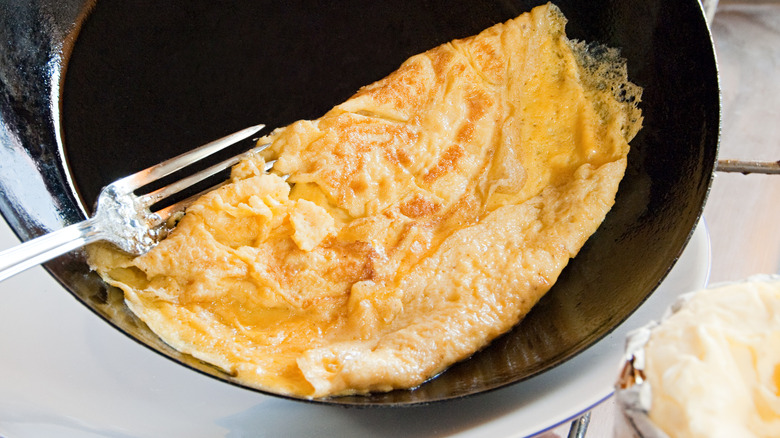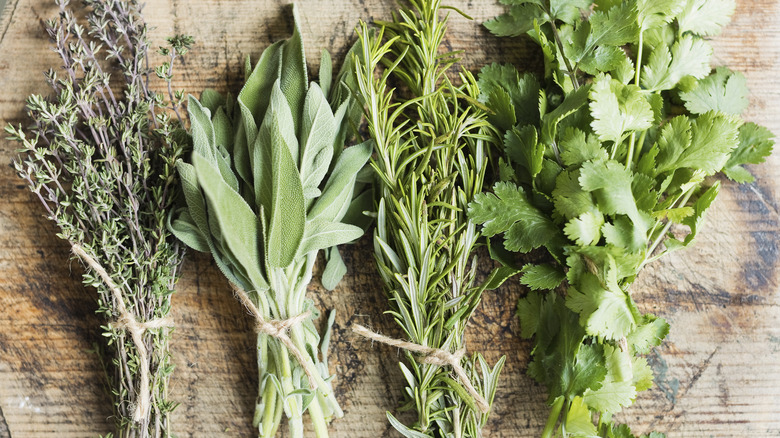The French Omelette Technique Julia Child And Jacques Pépin Swore By
Julia Child is most famous for making French cuisine accessible to the masses with her first book "Mastering the Art of French Cooking" and her subsequent groundbreaking television show "The French Chef." She and Jacques Pépin met for the first time in 1959 when he moved from France to the United States to work in Le Pavillion in New York City. They quickly developed a long-lasting friendship built on a love of French food — so much so that many of their techniques overlapped. One famous example of this is their method for making a classic French omelette.
The French omelette is cooked quickly to keep the outside light and fluffy with a soft texture inside, almost like custard. It's usually only flavored with butter and salt, though you can add cheese or fresh herbs. While many French chefs advise the use of a spatula to get a perfect roulade, Child and Pépin prefer the use of a fork, or — even better — no utensil at all. Both chefs cook their omelette by quickly agitating, or shaking, the pan in order to create the perfect, rolled-over shape.
Though omelettes are one of the most popular breakfast foods in the United States, most of us have only ever had the American version, a diner favorite that typically starts with eggs cooked to a lightly crisp texture, folded around fillings like smoked Gouda, bacon, or mushrooms. Though there are a few common omelet-making mistakes, French omelettes are fairly easy to cook.
Julia and Jacques' secret to the perfect French omelette
French omelettes come together incredibly fast. In fact, Julia Child is famous for preparing a French omelette in just 14 seconds on "The French Chef" in 1963. With just a few quick shakes of her pan, the eggs seem to magically roll into a neat, fluffy roulade that she turns out onto a plate. She then further demonstrations, showing the audience how to use a fork to aid the cooking process. Pépin's style is similar, though his teaching methods are more straight-forward.
To make a French omelette like Julia and Jacques, you'll need three eggs, several tablespoons of butter, salt and pepper, a bowl, fork, and a cast iron pan. Break the eggs into the bowl, add the salt and pepper, and whisk them with the fork for a few seconds. Next, place your cast iron pan over high heat and add the butter. Tilt the pan to ensure the bottom is completely coated in butter.
Next, pour the eggs into the hot, buttered pan and immediately begin shaking it back and forth across the burner to help the eggs begin to roll up on themselves. You may also use a fork to stir the eggs as you shake the pan to help them come together even faster. Once the bottom of the mixture is cooked and fluffy, tilt the pan away from you and use the fork to roll the omelette onto a warmed plate.
Adding flavor and flair, just like the French
Though the American brain is trained to associate egg dishes with breakfast, the French never eat omelettes first thing in the morning, preferring a croissant and cafe au lait instead. The French usually prepare omelettes as a light lunch, or later in the evening for dinner. Indeed, it's hard to argue with this logic, as who wouldn't want to come home to a delicious meal that takes just minutes to make?
Of course, not everyone enjoys a plain omelette, no matter how fresh and delicious the ingredients. While the French view stuffing your eggs with three or four ingredients as the wrong way to make an omelette, they do have a few acceptable variations for this simple dish. Jacques Pépin's favorite way to add flavor is the use of fresh herbs. He says chives, chervil, and tarragon are delicious, and can be used together or alone.
Some of Julia Child's top tips for flavoring omelettes include the use of herbs and ham. In the omelette episode of her show in 1963, she taught the audience first how to make a basic omelette flavored only with butter, salt, and pepper. A little later, she demonstrated how to heat ham to add it to the center of the roulade, and how to flavor the eggs with herbs before they go into the pan. For her and Pépin alike, the key was to choose simple flavors to avoid overwhelming the palate.


